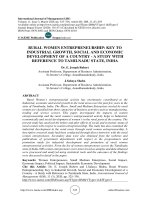Economic growth and economic development 4
Bạn đang xem bản rút gọn của tài liệu. Xem và tải ngay bản đầy đủ của tài liệu tại đây (61.7 KB, 1 trang )
Introduction to Modern Economic Growth
3.6.
3.7.
3.8.
3.9.
Estimating Productivity Differences
Taking Stock
References and Literature
Exercises
141
148
150
151
Chapter 4. Fundamental Determinants of Differences in Economic
Performance
4.1. Proximate Versus Fundamental Causes
4.2. Economies of Scale, Population, Technology and World Growth
4.3. The Four Fundamental Causes
4.4. The Effect of Institutions on Economic Growth
4.5. What Types of Institutions?
4.6. Disease and Development
4.7. Political Economy of Institutions: First Thoughts
4.8. Taking Stock
4.9. References and Literature
4.10. Exercises
155
155
160
163
178
199
202
206
207
208
211
Part 2.
213
Towards Neoclassical Growth
Chapter 5. Foundations of Neoclassical Growth
5.1. Preliminaries
5.2. The Representative Household
5.3. Infinite Planning Horizon
5.4. The Representative Firm
5.5. Problem Formulation
5.6. Welfare Theorems
5.7. Sequential Trading
5.8. Optimal Growth in Discrete Time
5.9. Optimal Growth in Continuous Time
5.10. Taking Stock
5.11. References and Literature
5.12. Exercises
215
215
218
226
229
232
233
241
245
246
247
248
250
Chapter 6. Dynamic Programming and Optimal Growth
6.1. Brief Review of Dynamic Programming
6.2. Dynamic Programming Theorems
6.3. The Contraction Mapping Theorem and Applications*
6.4. Proofs of the Main Dynamic Programming Theorems*
6.5. Fundamentals of Dynamic Programming
6.6. Optimal Growth in Discrete Time
6.7. Competitive Equilibrium Growth
6.8. Another Application of Dynamic Programming: Search for Ideas
iv
255
256
260
266
272
280
291
297
299









